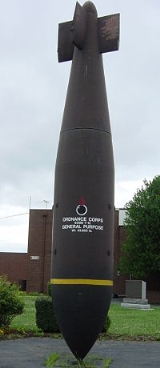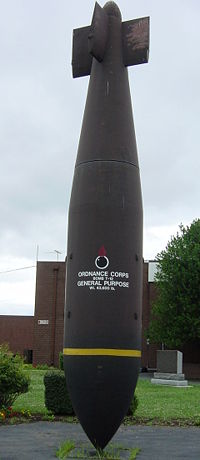
T12
Encyclopedia

Bomb
A bomb is any of a range of explosive weapons that only rely on the exothermic reaction of an explosive material to provide an extremely sudden and violent release of energy...
was developed by the United States
United States
The United States of America is a federal constitutional republic comprising fifty states and a federal district...
from 1944 to 1948. It was designed to attack targets invulnerable to conventional "soft" bombs, such as bunker
Bunker
A military bunker is a hardened shelter, often buried partly or fully underground, designed to protect the inhabitants from falling bombs or other attacks...
s and viaduct
Viaduct
A viaduct is a bridge composed of several small spans. The term viaduct is derived from the Latin via for road and ducere to lead something. However, the Ancient Romans did not use that term per se; it is a modern derivation from an analogy with aqueduct. Like the Roman aqueducts, many early...
s. It achieved this by having an extremely thick nose section, which was designed to penetrate deeply into hardened concrete structures and then detonate inside the target after a short time delay. This created an "earthquake effect".
The T-12 was a further development of the concept initiated with the United Kingdom
United Kingdom
The United Kingdom of Great Britain and Northern IrelandIn the United Kingdom and Dependencies, other languages have been officially recognised as legitimate autochthonous languages under the European Charter for Regional or Minority Languages...
's Tallboy
Tallboy bomb
The Tallboy or Bomb, Medium Capacity, 12,000 lb, was an earthquake bomb developed by the British aeronautical engineer Barnes Wallis and deployed by the RAF in 1944...
and Grand Slam
Grand Slam bomb
The Grand Slam was a 22,000 lb earthquake bomb used by RAF Bomber Command against strategic targets during the Second World War.Known officially as the Bomb, Medium Capacity, 22,000 lb, it was a scaled up version of the Tallboy bomb and closer to the original size that the bombs' inventor,...
weapons: a hardened, highly aerodynamic bomb of the greatest possible weight designed to be dropped from the highest possible altitude. Penetrating deeply in the earth before exploding, the resulting shockwave was transmitted through the earth into structures. The resulting camouflet could also undermine structures. The bomb could also be used against hardened targets. The T-12 was not a simple scale up of the M110, but incorporated modifications based on testing and calculations.
Originally set to meet a 42000 lb (19,050.9 kg) target weight (the maximum payload for the experimental Convair B-36 "Peacemaker"
Convair B-36
The Convair B-36 "Peacemaker" was a strategic bomber built by Convair and operated solely by the United States Air Force from 1949 to 1959. The B-36 was the largest mass-produced piston engine aircraft ever made. It had the longest wingspan of any combat aircraft ever built , although there have...
bomber), the original design with its hardened case was slightly less than 43,000. The final T-12 weighed 43,600 lb (nearly 20 metric ton
Tonne
The tonne, known as the metric ton in the US , often put pleonastically as "metric tonne" to avoid confusion with ton, is a metric system unit of mass equal to 1000 kilograms. The tonne is not an International System of Units unit, but is accepted for use with the SI...
s). This was twice the size of the United States' previous largest bomb, the Bomb, GP, 22,000-lb, M110 (T-14), the American-built version of the British Grand Slam. The B-36
Convair B-36
The Convair B-36 "Peacemaker" was a strategic bomber built by Convair and operated solely by the United States Air Force from 1949 to 1959. The B-36 was the largest mass-produced piston engine aircraft ever made. It had the longest wingspan of any combat aircraft ever built , although there have...
, was redesigned so it could carry the T12, although a converted B-29 Superfortress
B-29 Superfortress
The B-29 Superfortress is a four-engine propeller-driven heavy bomber designed by Boeing that was flown primarily by the United States Air Forces in late-World War II and through the Korean War. The B-29 was one of the largest aircraft to see service during World War II...
was used for testing.
Weapons of comparable size to the T-12, such as the BLU-82
BLU-82
The BLU-82B/C-130 weapon system, known under program "Commando Vault" and nicknamed "daisy cutter" in Vietnam and in Afghanistan for its ability to flatten a forest into a helicopter landing zone, is a 15,000 pound conventional bomb, delivered from either a C-130 or an MC-130 transport aircraft....
and GBU-43/B Massive Ordnance Air Blast bomb
GBU-43/B Massive Ordnance Air Blast bomb
The GBU-43/B Massive Ordnance Air Blast bomb is a large-yield conventional bomb developed for the United States military by Albert L. Weimorts, Jr. At the time of development, it was touted as the most powerful non-nuclear weapon ever designed...
s, were developed as latter-day US superbombs, but their utility is limited outside the realm of psychological weapons and demolition. Only the GBU-43/B remains in the inventory. They are not hardened and lack the hard target capability of the T-12 and its cousins. Precision-guided munition
Precision-guided munition
A precision-guided munition is a guided munition intended to precisely hit a specific target, and to minimize damage to things other than the target....
s (or "smart bombs") have mostly eliminated the need for gigantic charges in air-dropped bombs.
See also
- Massive Ordnance PenetratorMassive Ordnance PenetratorThe Massive Ordnance Penetrator GBU-57A/B is a project by the U.S. Air Force to develop a massive, precision-guided, "bunker buster" bomb...
- Nuclear bunker busterNuclear bunker busterBunker-busting nuclear weapons, also known as earth-penetrating weapons , are a type of nuclear weapon designed to penetrate into soil, rock, or concrete to deliver a nuclear warhead to a target. These weapons would be used to destroy hardened, underground military bunkers buried deep in the ground...
- Grand Slam bombGrand Slam bombThe Grand Slam was a 22,000 lb earthquake bomb used by RAF Bomber Command against strategic targets during the Second World War.Known officially as the Bomb, Medium Capacity, 22,000 lb, it was a scaled up version of the Tallboy bomb and closer to the original size that the bombs' inventor,...
- MOABGBU-43/B Massive Ordnance Air Blast bombThe GBU-43/B Massive Ordnance Air Blast bomb is a large-yield conventional bomb developed for the United States military by Albert L. Weimorts, Jr. At the time of development, it was touted as the most powerful non-nuclear weapon ever designed...
- BLU-82BLU-82The BLU-82B/C-130 weapon system, known under program "Commando Vault" and nicknamed "daisy cutter" in Vietnam and in Afghanistan for its ability to flatten a forest into a helicopter landing zone, is a 15,000 pound conventional bomb, delivered from either a C-130 or an MC-130 transport aircraft....
- Aviation Thermobaric Bomb of Increased Power
External Links
- "Big Bomb Tight Fit In B-29 Bomb Bays" , October 1951, Popular Science photo showing T-12 being fitted to B-29 bomb bay
- USA’s 30,000 Pound Bomb," Defense Industry Daily Article on the new Massive Ordnance Penetrator (MOP), has history of earlier systems.
- "The Extra-Super Blockbuster" by Dr. William S. Coker Air University Review, March-April 1967.

